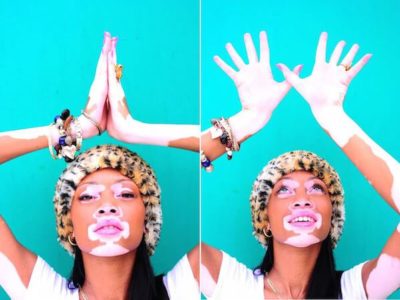NW35, NC5, N6, N7, sand-beige and golden brown. These shades of makeup fit my skin tone perfectly. I’ll admit, I’m obsessed with makeup. I refuse to go anywhere without mascara and I spend more than I’d like to admit at MAC and Sephora—even if most of my makeup comes from CVS (hello, college budget).
Although I like my cat-eye sharp enough to kill a man, I don’t wear eyeliner often. Or lipstick. In fact, I’m proud in knowing I only need 10 different products to get ready in the morning. Despite this point, half the time people can’t tell I’m wearing any makeup. I feel like I’m running a crazy experiment where I see how much foundation, concealer and powder I can pile onto my face and trick people into thinking I’m all natural.
Since the start of my college career, only a handful of people have seen me without makeup. The amount of encounters remains slim because I have vitiligo. Vitiligo defines itself as a skin discoloration disorder where you lose the pigment in your skin. According to the American Vitiligo Research Foundation, vitiligo affects 1–2 percent of the world’s population. The cause of vitiligo is not known. However, researchers believe it may be an autoimmune disease. In vitiligo, the immune system mistakenly attacks the melanocytes in the skin. Treatment options include pills, creams, exposure to ultraviolet light, skin grafting and removing the color from other areas so they match the white parts of your body.
I’ve had vitiligo since the age of 13. As a tan Latina, the depigmentation looks quite stark. I remember feeling afraid of people calling me a Dalmatian or a raccoon. Due to the vitiligo, I started wearing makeup in middle school solely to cover my spots—that’s how I refer to them.
Slowly but surely, my makeup skills improved and I started finding more expensive brands that accurately concealed these insecurities. While I’m not embarrassed of my spots, I can tell when people aren’t looking me in the face and sneak a glimpse at my left cheek, or what’s left of my vitiligo.
While the diagnosis proved to be the most devastating thing to my seventh grade self, vitiligo doesn’t affect me anymore. Growing up, the white patches on my skin covered nearly the entire left side of my face, including my hairline. The lack of pigment made my hair grow without color leaving a white streak in my practically black, curly hair.
After using a topical medication prescribed by my dermatologist, I forget about the spots on my face. To be honest, I’d say the spots became unnoticeable. Since the vitiligo has lessened, I run through significantly less makeup and sunscreen. Applying a layer of makeup before leaving the house used to feel like an obligation, but this experience taught me it’s actually a choice.
When I was younger, I would think to myself how lucky I got to only have the discoloration on my face, where I can cover it with makeup. In high school I’d go through bottles of foundation and on a hot afternoon after marching band practice I got wicked sunburns. Thankfully, the troubles of 15-year-old me seem foreign now. However, I acknowledge that my experience with vitiligo is vastly different from many others with this disorder.
Occasionally, I run into people who have vitiligo on their arms, hands, shoulders, legs or feet wearing their “spots” like a scout badge. Today, I look at those with vitiligo with admiration, not pity. I used to feel incredibly self conscious about my vitiligo, but once I started college I became okay with people seeing me without the makeup shield. College taught me that nobody’s perfect and our everyday look doesn’t always match up the Instagram selfie featuring 100 likes. I think we get caught up in trying to “pull it together” that we forget it’s okay to not feel or look A1 every minute of the day.
Growing up, I wish I could’ve been more exposed to people with imperfect skin in the media. I don’t think we’re there yet. Nor do I think we’ll be seeing men and women with skin disorders, scars or acne within the media. Regardless of whether or not you wear a mountain of makeup or no makeup, I think it’s important for us to not perpetuate the idea that a one perfect way to look exists.
Contour or no contour, beneath the foundation and concealer, my spots remain there and they’re still a part of me.



















